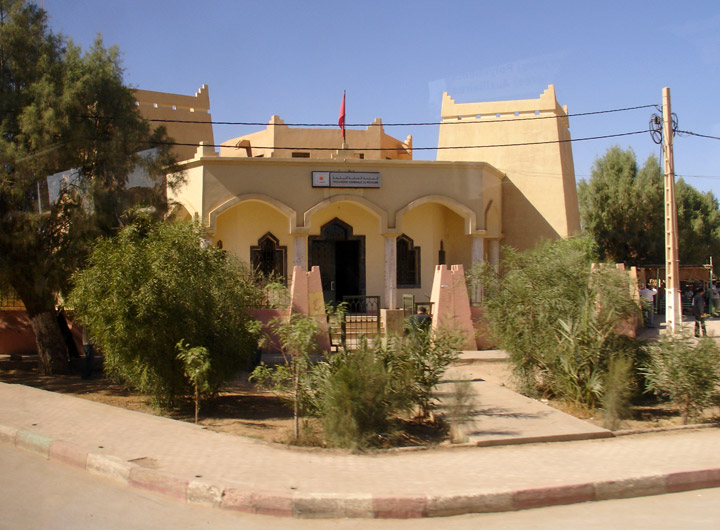EASTERN MOROCCO
 This image shows an area of eastern Morocco. Morocco is located in northwest Africa, bordered by the Mediterranean Sea, the Atlantic Ocean, Mauritania, and Algeria. Morocco is a leading producer and exporter of phosphates and also mines iron ore, copper, lead, zinc, cobalt, molybdenum, and coal. The image shows a portion of the Atlas mountains near the town of Rissani, which is located in northeast Morocco about 50 km (31 mi) from the Algerian border. In this image, dark areas between brighter rock outcrops are channels covered in sand that serve as conduits for seasonal streams that run through the dry desert region. The image was obtained by SIR-C/X-SAR on the Space Shuttle Endeavour on April 15, 1994 and shows an area about 34 km (21 mi) on a side.
This image shows an area of eastern Morocco. Morocco is located in northwest Africa, bordered by the Mediterranean Sea, the Atlantic Ocean, Mauritania, and Algeria. Morocco is a leading producer and exporter of phosphates and also mines iron ore, copper, lead, zinc, cobalt, molybdenum, and coal. The image shows a portion of the Atlas mountains near the town of Rissani, which is located in northeast Morocco about 50 km (31 mi) from the Algerian border. In this image, dark areas between brighter rock outcrops are channels covered in sand that serve as conduits for seasonal streams that run through the dry desert region. The image was obtained by SIR-C/X-SAR on the Space Shuttle Endeavour on April 15, 1994 and shows an area about 34 km (21 mi) on a side.Moroccan artifacts go a long way back and the carpet is certainly the oldest of all of them. Here is a country famous for its carpets and carpet production and a long history to go with it.

With household names such as Kilim (embroidered carpet from Mid Atlas), Glawa (stitched, knotted and embroidered from the High Atlas) and Taznaght (knotted carpet from the High Atlas) you have found a product which is a must to take home with you.
The loom is traditionally made from the local wood of the valley and is part of the tradition of each household in Morocco, a country famous for its carpets, rugs and mats. Khali from the Brothers Amazoze Imlil in the High Atlas Mountains have the last say in the village on your way up the valley towards Toubkal.



Although the carpets from Eastern Morocco have attracted little scholarly as well as commercial attention, their importance and influence on the development of rural Moroccan weaving culture - particularly on the one of the Middle Atlas - cannot be underestimated.
As in the Middle Atlas, the carpets were generally used as sleeping mats and covers but due to the lower regions and the milder climate they only have a pile about 2cm high, and various forms of symmetric knots, asymmetric knots as well as the Berber knot are used. The sizes normally vary between 160 and 220 cm in width and from 3 up to 10 meters in length.
Pile carpets in Eastern Morocco can be subdivided into a female style similar to the traditions in the Middle Atlas and a male style, which has an affinity to the traditions in Algeria and Tunisia. While the women produced the carpets for their own families in a self supporting nomadic economic system, the male traditions base on a system of specialised professional masterweavers (Arab.: mallem).
The very large masterweaver carpets, sometimes up to 10 meters long, were made for wealthy families among the northern tribes of the Metalsa, Beni bou Yahi, Beni bou Zeggou and the Beni Snassen. Such pieces were regarded as extremely prestigious and served as examples and source of inspiration for the more widespread female carpet production. Occasionally the eastern Moroccan masterweavers also worked in the northern and eastern middle Atlas and hence were of significant influence to these regions too.
The design scheme of these carpets shows the traditional simple geometric Berber motifs such as lozenges, triangles, crosses etc. inscribed in a regular, symmetric overall lozenge grid-composition with well balanced colours containing high amounts of deep indigo blue and green in old examples. Borders are typical, but usually the ones along the